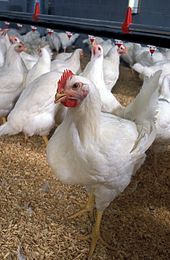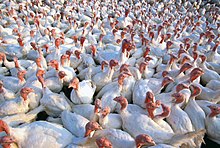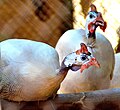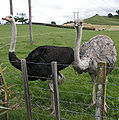poultry
Poultry is the generic term for all bird species that are bred as farm animals or domestic animals and are suitable for human consumption. Sometimes the term is synonymous with domestic uses or poultry, sometimes it also includes game birds , game birds that are specifically hunted for human consumption, with a. Depending on how birds are also in commercial poultry , fancy fowl and ornamental poultry or fat poultry , lean poultry and wild fowl distinguished.

Zoological order of the poultry
Most poultry species belong to the hen or goose birds and thus to the large group of Galloanserae . Depending on the system, pigeons are also included.
| poultry | ||||||||||
|---|---|---|---|---|---|---|---|---|---|---|
| class | Birds (aves) | |||||||||
| order | Chicken birds (Galliformes) | Goose birds (Anseriformes) | Pigeon birds (Columbiformes) | |||||||
| family | Pheasants (Phasianidae) | Guinea fowl (Numididae) | Duck birds (Anatidae) | Pigeons (Columbidae) | ||||||
| genus | Combed chicken ( Gallus ) | Turkeys ( Meleagris ) | Earth quail ( Coturnix ) | Helmeted guinea fowl ( Numida ) |
Field geese ( anser ) |
Actual ducks ( Anas ) | Cairina | Field pigeons ( Columba ) | ||
| Art | Bankiva chicken ( Gallus gallus ) | Turkey ( Meleagris gallopavo ) | Japanese quail ( Coturnix japonica ) | Helmet guinea fowl ( Numida meleagris ) | Greylag goose ( anser anser ) | Swan Goose ( Anser cygnoides ) | Mallard Duck ( Anas platyrhynchos ) | Musk duck ( Cairina moschata ) | Rock dove ( Columba livia ) | |
Chicken
- House chicks (French, English poussin ), also called Mistkratzerle in Baden or Mistkratzerli in Switzerland, are animals of less than 650 g slaughter weight (weighed without offal, head and feet) according to the marketing standard . The meat is very tender and slightly yellow. It is originally a North German name for small cocks with a slaughter weight of 300 to 500 g. The name comes from the earlier rural way of keeping the chicks in the living area ("room") to protect the chicks from the cold. Slaughter takes place after 21 days.
- Contrary to what the name suggests, chickens or broilers are chickens of both sexes weighing between 800 and 1200 g. The fattening hybrids used in today's fattening are bred for very high daily weight gains and reach their slaughter weight after 30–40 days; in slow growing breeds, which are mainly used in organic agriculture , after 72 days. Heavier and older chickens are also called poulards or broilers.
- Poulards are young broiler chickens that are slaughtered at seven to twelve weeks, i.e. before they reach sexual maturity . They weigh from 1200 to over 3500 g. Corn poulards are heavy (over 1200 g sales weight) specimens of the corn chicken. A corn chicken is a chicken that has been fed mostly corn. The skin and meat of the corn chickens are yellowish.
- Capons are fattened, castrated roosters weighing between 1500 and 2000 g. There is hardly any demand for them in Germany, but they are popular in other countries due to their special meat taste.
- Laying hens are hybrid chickens that have been specifically bred to lay eggs. There are predominantly breeding lines that lay only brown or only white eggs.
- Roosters are sexually mature males that are hard to come by in stores. The older the animals get, the tougher their meat becomes. The preparation is accordingly demanding. The inherent taste is more intense than that of younger animals and, depending on the breed, is reminiscent of game . Adult animals can weigh 3500 g and more. The traditional Italian dish cibreo, already described by Pellegrino Artusi , can be made from the combs, wattles, testicles and other innards .
- Soup chickens are usually 12 to 15 month old laying hens, they weigh between 1000 and 2000 g. Soup chickens are particularly aromatic, but they have to be cooked longer, their meat is tough when fried.
Turkeys
The turkey is usually a turkey , in Switzerland as Trute referred.
- Baby turkeys are called young animals weighing 2,000 to 3,000 g. They are less aromatic and juicy than older animals.
- Young turkeys are around ten weeks old and have a slaughter weight of 3000 to 4000 g.
- Turkeys or turkeys are 15 to 20 weeks old. The females weigh up to 12 kg, the males up to 20 kg. In Europe they are mainly sold in pieces or processed, in North America they are often prepared in one piece on Thanksgiving .
Geese
- Early fattening geese are around 10 to 12 weeks old and weigh 2000 to 3400 g.
- Young geese are around 9 months old and weigh 4000 to 6000 g.
- Oat-fattened geese can be more than a year old, but are rarely offered. They often weigh over 6000 g.
- Grazing geese are kept outdoors, where they feed on grass supplemented with grain. Maize feeding is avoided in order to avoid fatty liver.
Ducks
|
|
|
|
|
|
Wild fowl
|
|
|
|
|
|
|
|
|
|
|
|
Other poultry
DoveThe pigeons offered are cultivated forms of the rock pigeon . They are slaughtered after about four to eight weeks, their weight is between 350 and 1200 grams. Their meat is reddish and aromatic, the taste is slightly reminiscent of game. The pigeon is of little importance in industrial animal husbandry, which is why slaughtered animals have to be obtained almost exclusively from hobby breeders. If you are interested in an economic breed, letter , Hubble and King pigeons will help. Furthermore, breeds from the groups of shaped pigeons , chicken pigeons and colored pigeons as well as original crop pigeons , so-called peasant crookers , are particularly suitable . |
|
ostrichOstriches ready for slaughter weigh 75 to 100 kg with a meat content of almost 50%. The dark ostrich meat is reminiscent of beef in appearance and taste ; it is very low in fat and has a nutty taste. Upper and lower leg pieces are sorted according to the degree of tenderness and offered as fillet (very tender) and steak (tender). Since the ostrich is a flightless flightless flightless bird, unlike flightable poultry, it has little breast meat. |
|
Poultry products
The poultry production takes place mainly for the production of animal protein in the form of meat and eggs (rarely especially chicken, and quail and ostrich eggs). The feathers of some species (goose down, peacock feathers, ostrich feathers) are also used, and leather is also used in ostriches. Chicken eggs are also used to obtain vaccines .
Poultry meat is low in fat in muscle tissue and, like other meats , contains protein , vitamins and minerals . Because of the frequent contamination by Salmonella and Campylobacter , poultry meat should always be cooked through and cross-contamination avoided during processing .
Cuts
Since most bird species hardly differ in terms of their anatomy, the subdivision or cutting of poultry of all species is largely the same.
- Chest : The chest or flight muscles make up about 25 to 35 percent of the total weight. It is divided into the larger outer fillet (the pectoralis, which is used to lower the wings) and the much smaller, more tender inner fillet (the supracoracoid to lift the wings). The breast is particularly lean and tends to dry out when cooked for a long time.
- Club , thigh , mallet : The club contains numerous smaller muscles that are separated from one another by thin layers of fat. It is more aromatic than the breast, sometimes darker in color, and can be cooked longer. For larger poultry, thighs and lower legs are also offered separately, boneless chicken thighs as "chicken steak".
- Wings : The wings contain very little meat; it is similar to that of the clubs. They are offered as part of the poultry meat . Especially in the US food grilled or fried chicken wings (are chicken wings ) popular as a snack.
- Back : Unlike mammals, the back of poultry hardly contains any meat. It is suitable for boiling poultry broth and also belongs to the poultry meal.
- Pfaffenschnittchen : The Pfaffenschnittchen lie in pairs at the level of the legs next to the spine. Their meat is considered to be of particularly high quality.
- Rump : The rump consists essentially of fat and glandular tissue. The secretion is used by the birds to care for their plumage. From a culinary point of view, the rump is worthless; it is sometimes recommended to remove it before preparing whole animals, as the rump gland can have an unpleasant, tranquil taste.
- Neck (not shown): The neck contains little meat around the spine, which is long-fiber, dark and aromatic. It belongs to the little poultry. Traditionally, the skin of the goose neck is used as a casing to make a kind of cooked sausage from cooked goose pills .
consumption
Around 20% of the meat consumed in the EU is poultry (annual per capita consumption in 2002: 13.3 kg). In Germany , 13.2 kg of poultry were consumed per capita in 2018, with a total meat consumption of 60.1 kg.
| Development of the per capita consumption of poultry meat in kg in Germany |
|||||||||||||||||||
|---|---|---|---|---|---|---|---|---|---|---|---|---|---|---|---|---|---|---|---|
| 1999 | 2000 | 2001 | 2002 | 2003 | 2004 | 2005 | 2006 | 2007 | 2008 | 2009 | 2010 | 2011 | 2012 | 2013 | 2014 | 2015 | 2016 | 2017 | 2018 |
| 9.1 | 9.5 | 10.8 | 10.4 | 10.5 | 10.5 | 10.4 | 10.0 | 10.6 | 10.9 | 11.2 | 11.1 | 11.3 | 11.3 | 11.5 | 11.4 | 12.0 | 12.4 | 12.4 | 13.2 (preliminary) |
| (Source: German Butchers Association) | (Source: Federal Association of the German Meat Industry eV) | ||||||||||||||||||
See also
- Poultry meat
- Poultry production and intensive animal husbandry
- Inheritance of color and markings in the domestic fowl
literature
- Klaus Damme, Ralf-Achim Hildebrand: Poultry farming. Laying hens, chickens, turkeys, management, animal welfare, the environment, economy. Ulmer, Stuttgart 2002, ISBN 3-8001-3929-4 .
- Franz-Viktor Salomon: Textbook of poultry anatomy. Gustav Fischer, Jena and Stuttgart 1993, ISBN 3-334-60403-9 .
- Günter Stach: Poultry houses and outlets. Advice on planning and building poultry houses taking into account their facilities and outdoor facilities. Oertel and Spörer, Reutlingen 2004, ISBN 3-88627-506-X .
- Alice Stern: Poultry. Keep it natural and appropriate to the species. Franckh-Kosmos, Stuttgart 2001, ISBN 3-440-09022-1 .
- Christian Teubner, Sybil Countess Schönfeldt , Siegfried Scholtyssek (eds.): The big book of poultry. Commodity knowledge, kitchen practice and recipes from breeding poultry. Gräfe and Unzer, Munich 2004, ISBN 3-7742-6972-6 .
Web links
- Poultry on Lebensmittellexikon.de
- Product information poultry on was-wir-essen.de
- Keeping poultry - Information from the Federal Food Safety and Veterinary Office
Individual evidence
- ↑ Gerald Rimbach, Jennifer Möhring, Helmut F. Erbersdobler: Food and goods knowledge for beginners. Springer, 2010, ISBN 978-3-642-04485-4 , p. 70.
- ↑ The new kitchen dictionary. From Aachener Printen to intermediate ribs. 11th edition Dtv, Munich 2007, p. 180, ISBN 978-3-423-36245-0 .
- ↑ based on teaching materials from Martin Wehner, Anhalt University
- ↑ World : Why you shouldn't wash raw poultry after all. , from September 12, 2017, loaded on December 1, 2017
- ↑ NDR : Frozen chickens contaminated with Campylobacter germs , from September 4, 2017, accessed on December 1, 2017
- ↑ Meat consumption and consumption per capita of the population . In: bvdf.de . Archived from the original on August 14, 2015. Info: The archive link was inserted automatically and has not yet been checked. Please check the original and archive link according to the instructions and then remove this notice. Retrieved December 27, 2016.
















